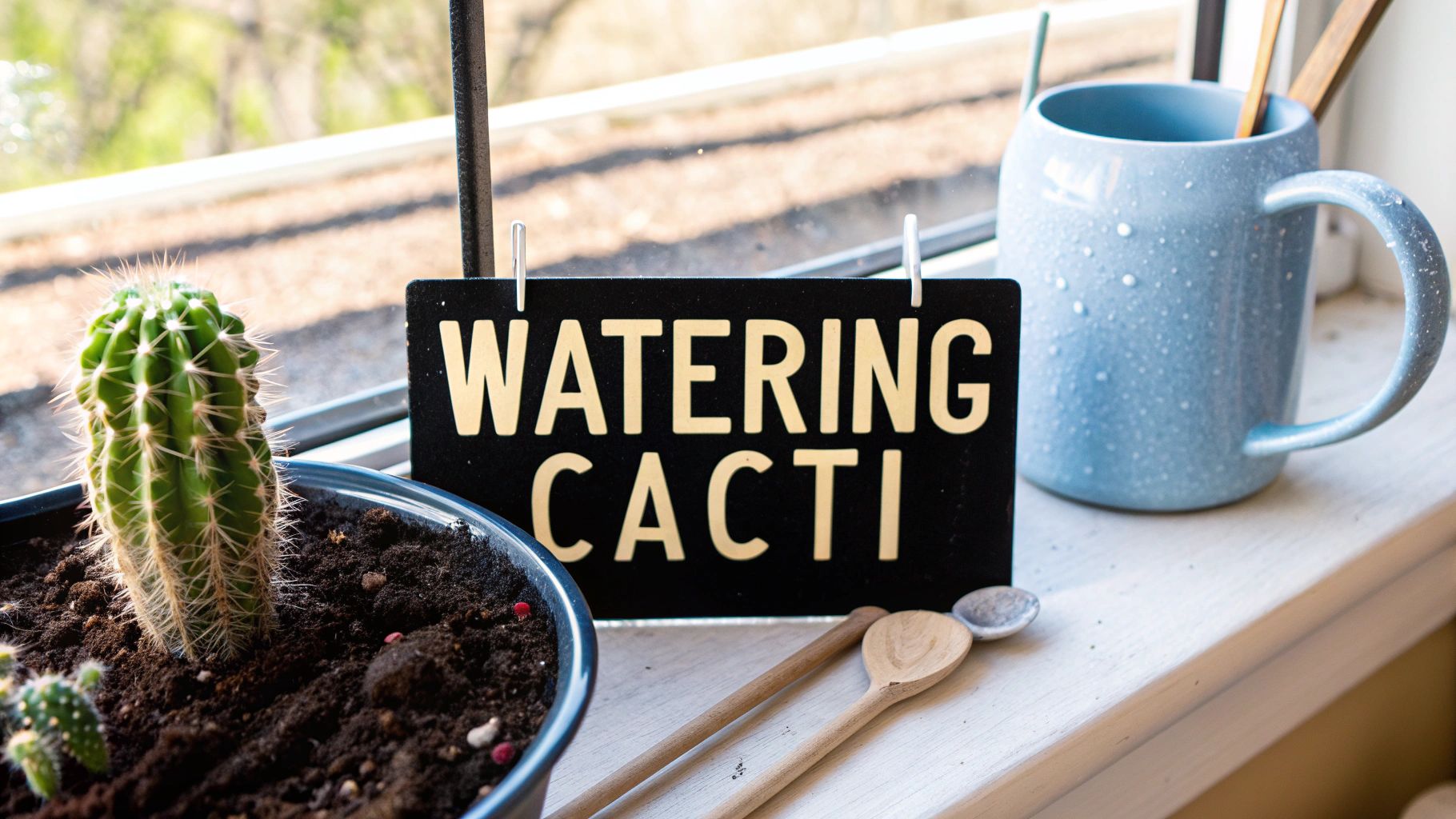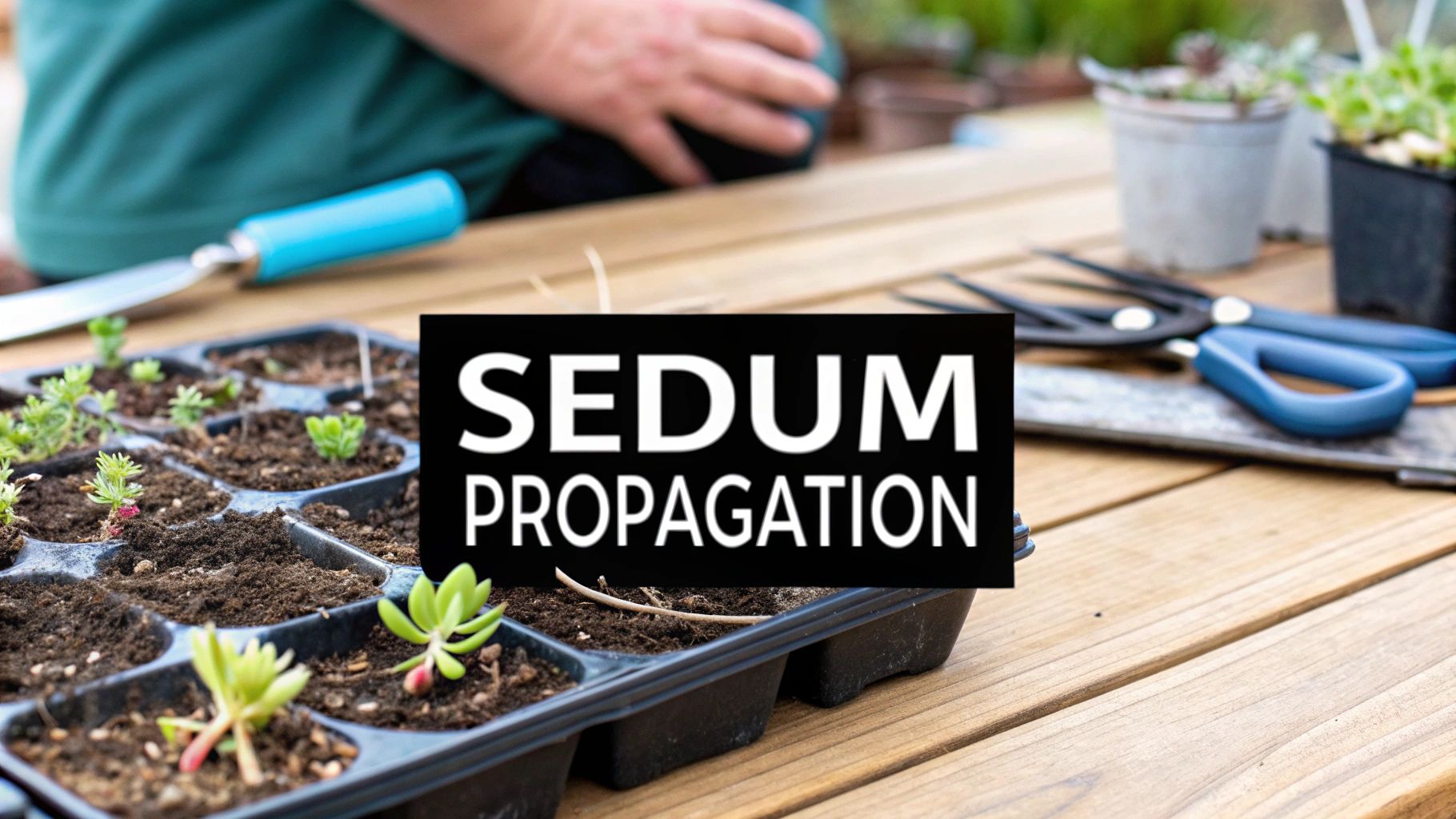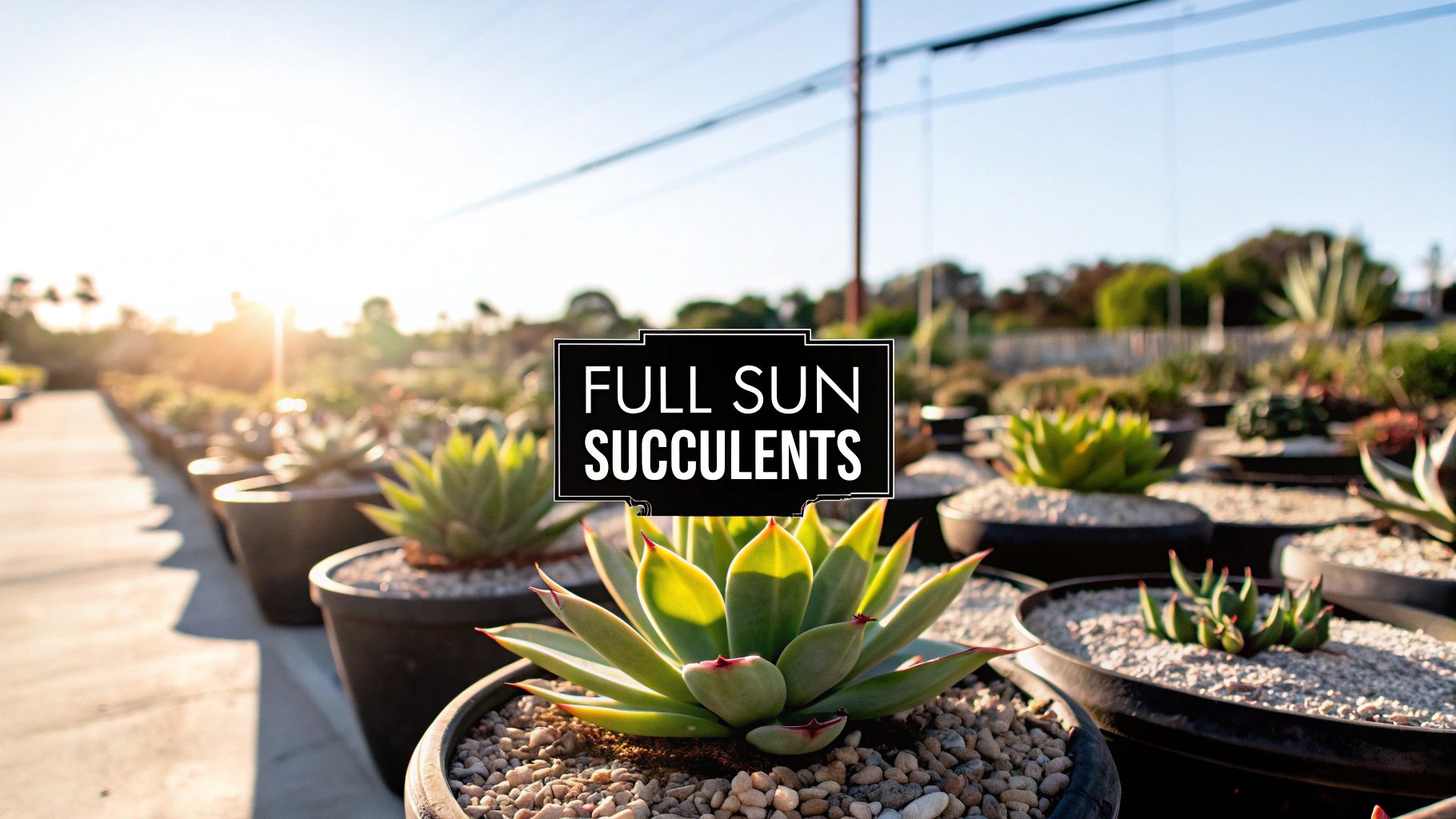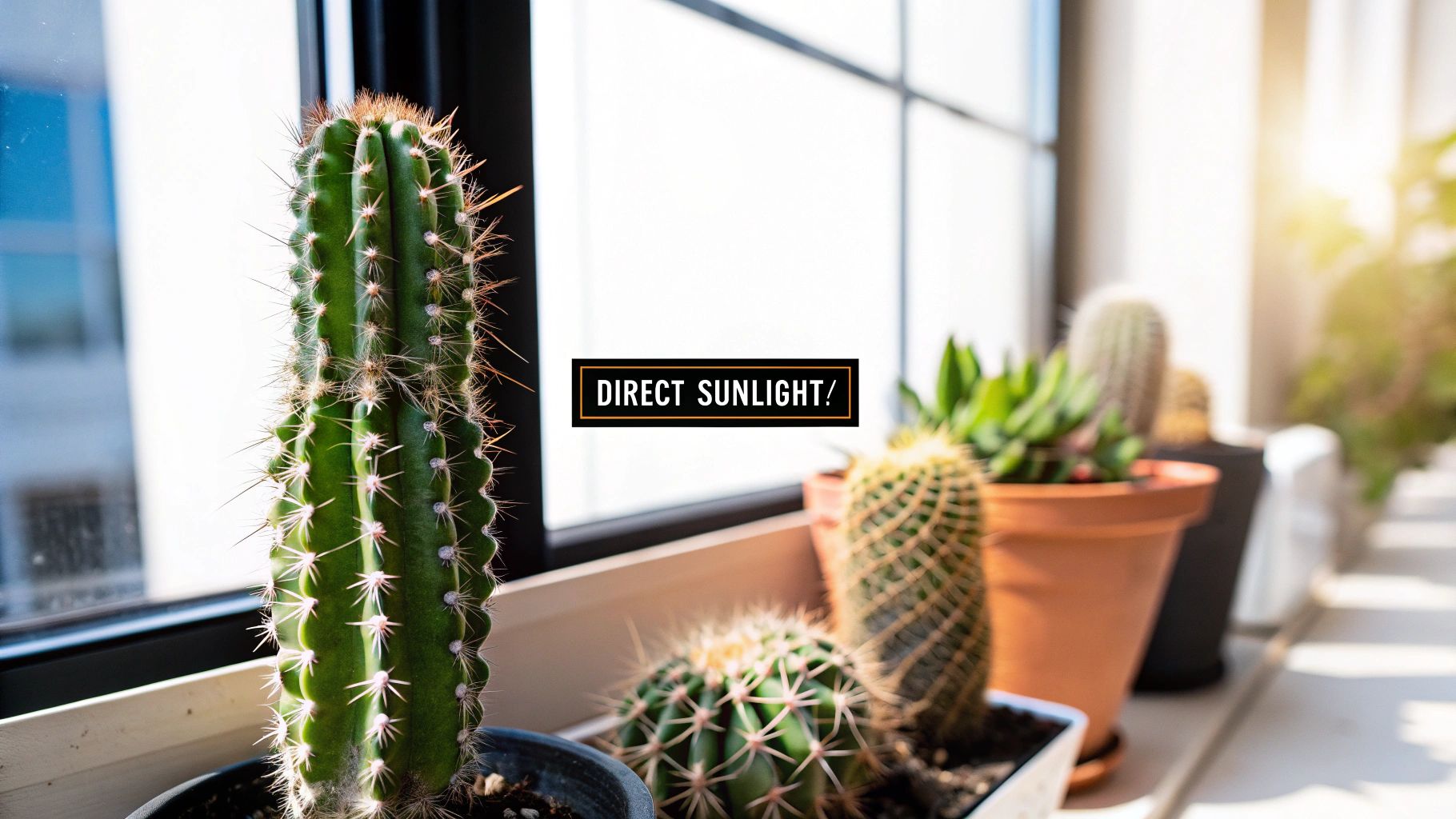When it comes to watering cacti, you need to forget everything you know about traditional houseplants. It’s not about sticking to a rigid weekly schedule; it’s about mastering the right technique. The secret is the “soak and dry” method: give the soil a thorough drenching, then let it become bone-dry before you even think about watering again. This one simple principle is the key to avoiding the two biggest killers of cacti—underwatering and deadly root rot.
Rethinking How You Water Cactus Plants

It’s easy to get cactus care wrong. Most people fall into one of two traps. The first is believing the myth that cacti thrive on total neglect, which leads to a shriveled, dehydrated plant. The second is treating them like a thirsty fern, watering far too often and inviting fatal root rot. The sweet spot is somewhere in the middle.
While these desert dwellers are incredibly tough, they still have specific needs to truly thrive indoors. The first step is a mental shift. Stop looking at your calendar and start looking at your plant and its soil.
The Foundation of Proper Watering
The best way to care for a cactus is to copy its natural environment. Deserts don't get gentle, frequent showers. They get long, dry spells broken by sudden, torrential downpours that completely saturate the ground. That’s exactly what the "soak and dry" method recreates.
This is why lightly misting your cactus is one of the worst things you can do. A little spritz only dampens the top layer of soil and does absolutely nothing for the roots below. A deep soak, on the other hand, ensures the entire root system gets a proper drink, encouraging strong, healthy growth as the roots search for moisture during the dry period.
"The single most common mistake is not the frequency but the method. A timid splash of water is worse than no water at all. Cacti need a commitment to either drenching or waiting."
Avoiding Common Pitfalls
It's shocking how many cacti meet their end due to watering mistakes. In fact, over 50% of indoor cactus plant failures are a direct result of improper watering. One horticultural study even found that cacti watered too frequently had a 60% higher chance of developing deadly fungal infections. This really drives home how vital it is to let that soil dry out completely. For more on cactus plant market insights, check out the analysis from Verified Market Reports.
To make it crystal clear, let's compare the right approach with some all-too-common mistakes.
Cactus Watering At A Glance: Soak and Dry Method
Here’s a quick summary of the fundamental 'soak and dry' watering technique compared to common incorrect methods.
| Watering Technique | Description | Why It Works (or Doesn't) |
|---|---|---|
| Soak and Dry | Thoroughly saturate the soil until water runs out the drainage holes. Wait for the soil to dry out completely before repeating. | Mimics the natural desert cycle of drought and downpour, encouraging strong root growth and preventing rot. |
| Scheduled Misting | Lightly spraying the cactus and topsoil with water every few days. | Fails to deliver water to the roots where it's needed. Increases the risk of fungal spots on the plant's skin. |
| Small Sips | Giving a small amount of water on a frequent, fixed schedule (e.g., weekly). | Leads to shallow root development and keeps the lower soil levels chronically dry, eventually dehydrating the plant. |
As you can see, giving your cactus a deep, infrequent soak is the only method that truly supports its long-term health, directly mirroring the conditions it evolved to thrive in.
Mastering the Art of Watering Your Cactus
Once you get the hang of the “soak and dry” philosophy, you’re well on your way. Think of it less like a strict rulebook and more like a rhythm you learn for your specific cactus and home environment. The goal is straightforward: drench the soil completely, then let it become bone dry before you even think about watering again.
There are a couple of fantastic ways to get that deep soak, and each has its own perks.
The Top-Watering Technique
This is the classic, most common method for a reason—it’s simple and effective. Just pour water evenly over the top of the soil until it starts running freely out of the pot’s drainage holes.
Don’t be shy with the water! A light sprinkle won't cut it. You need a thorough drench to make sure the entire root ball has a chance to drink.
After watering, let the pot sit in a sink or on a draining rack for 10-15 minutes. Getting rid of that excess water is non-negotiable. A cactus sitting in a water-filled saucer is the fastest way to invite root rot, which is often a death sentence. Once it has stopped dripping, it's safe to return to its home.
This image is a great visual reminder of how your watering schedule will shift throughout the year.

As you can see, cacti need far less water during their winter dormancy. This is a critical adjustment to keep them healthy.
The Bottom-Watering Approach
Bottom-watering is another excellent option, and it's my personal favorite for cacti with dense spines or any that are fussy about getting their stems wet. It encourages strong root growth as the roots have to "reach" down for moisture, just as they would in nature.
Here’s how you do it:
- Find a basin, tray, or even a sink and fill it with a couple of inches of water.
- Set your cactus pot right into the water.
- Let it soak for 15-30 minutes. The soil will act like a sponge, wicking water up through the drainage holes.
- The soil is fully saturated when the top surface feels slightly damp.
- Pull the pot out, let any excess water drain away completely, and you're done.
This method hydrates the soil evenly from the bottom up without a single drop touching the body of the cactus. While the principles are similar for many desert plants, you can find more specific advice in our guide on how to water succulent plants.
Choosing the Right Kind of Water
It might sound overly particular, but the type of water you use really does make a difference. Tap water, especially in "hard water" areas, is full of minerals that can build up in the soil over time. This buildup can eventually harm the roots.
Rainwater or distilled water are the absolute best choices for your cacti. They're pure and free of the chemicals and mineral salts found in most tap water. This prevents the white, crusty buildup you sometimes see on the soil surface or the pot itself.
If rainwater isn't an option, you can let a pitcher of tap water sit out uncovered overnight. This allows some of the chlorine to evaporate, making it a bit gentler on your plant.
The Ultimate Soil Dryness Test
So, how do you really know if the soil is completely dry? The surface can be deceiving. The best way to be certain is with a simple tool you probably already have: a wooden skewer or a chopstick.
Gently slide the skewer all the way into the soil, staying away from the base of the plant to avoid the main roots. Let it sit for a few seconds, then pull it out.
- Clean and dry? It’s watering time.
- Damp soil clinging to it? Hold off. Your cactus isn’t thirsty yet.
This simple trick takes all the guesswork out of the equation. It's a foolproof way to ensure you're only watering when your cactus truly needs it.
Learning to Read Your Cactus for Thirst

If you really want to get good at watering your cactus, the single best thing you can do is throw away the calendar. Seriously. Stop watering on a schedule and start learning to read the plant itself. Cacti give off clear, if sometimes subtle, signals when they need a drink.
Learning these cues turns plant care from a routine chore into more of a conversation. This intuitive approach is far more reliable because your cactus’s needs are always changing with the seasons, the amount of sunlight it gets, and the temperature in your home. By watching the plant, you can respond to what it actually needs, right when it needs it.
Visual Clues of a Thirsty Cactus
Your cactus will physically change when it's getting thirsty. It's built to use its stored water to get through dry spells, and as those reserves dwindle, its appearance will shift. The trick is to catch these signs early, just as the plant is beginning to ask for water.
Keep an eye out for these common indicators:
- Slight Wrinkling: The skin, which should be plump and firm, might start showing some fine lines. You'll often see this first on the main body or pads.
- Deeper Ribs: On ribbed cacti, like a classic Barrel Cactus, the ridges will look more pronounced as the fleshy parts between them shrink.
- Loss of Firmness: Gently (and carefully!) give your cactus a little squeeze. A hydrated plant feels solid, but a thirsty one will feel a bit soft or have some give.
- Duller Color: The vibrant, healthy green might fade to a duller, less lively shade when the plant is getting dehydrated.
For instance, you might notice a once-plump Prickly Pear pad looks a little deflated. Or a tall, columnar cactus might seem less rigid than it usually is. These aren't signs of failure; they're direct communications from your plant.
The Dangers of Overwatering
Just as crucial as spotting thirst is knowing the signs of too much water. Honestly, overwatering is far more dangerous and harder to come back from than a little underwatering. The real damage—root rot—happens underground, so the signs you see above the soil often mean the problem is already advanced.
Watch out for these red flags:
- Mushy Base: The classic, dreaded sign of root rot is a soft, squishy base right at the soil line. It can also look dark or even black.
- Yellowing Stems: While thirst can make a cactus look dull, a sickly yellow hue often points to root distress from too much moisture. You can dig deeper into why a cactus might be turning yellow in our specific guide on the topic.
- Unstable Plant: If your cactus suddenly feels wobbly in its pot, its roots might be rotting away and losing their ability to anchor it.
One of the simplest and most effective checks I've learned over the years is the "lift test." A pot with bone-dry soil is surprisingly light. After you give it a good, deep watering, it will feel significantly heavier. This physical cue is an amazing way to gauge the moisture level without even looking at the plant.
By combining a quick visual inspection with the lift test, you’ll quickly develop a real feel for your cactus’s watering cycle. This hands-on method helps you build a better connection and ensures your plant thrives.
How to Adjust Your Watering for Every Season
One of the biggest mistakes I see people make with cacti is sticking to the same watering schedule year-round. A routine that works wonders in the middle of summer can quickly lead to a soggy, rotted mess in the dead of winter. Your cactus is keenly aware of the seasons, and your watering habits need to reflect that.
Think of spring and summer as the cactus's growing season. The days are longer, the light is more intense, and your plant is busy putting out new growth or even getting ready to flower. All that work takes energy, and energy requires water.
During this active phase, you'll notice the soil dries out much more quickly. You might find yourself watering as often as every two to four weeks. Of course, this all depends on your home's unique climate. A cactus basking in a hot, south-facing window is going to be far thirstier than one sitting in a cooler room with less direct sun.
Navigating Fall and Winter Dormancy
Once autumn rolls in and the days get shorter, your cactus starts to wind down. This is the beginning of its natural dormant period, a time of rest that carries it through the winter. Growth slows to a crawl, and its water needs drop dramatically.
This is where so many well-intentioned plant parents go wrong. Sticking to a summer watering schedule in winter is the fastest way to kill a cactus. During dormancy, you have to pull back—a lot. Watering just once every six to eight weeks, or sometimes even less, is plenty. You're just giving it enough to keep the roots from completely drying out while it rests.
My personal rule for winter watering is simple: when in doubt, don't. If you think it might be time to water, wait another week. It’s always safer to err on the side of too dry than too wet with a dormant cactus.
This seasonal rhythm is baked into their DNA. It mimics the wet and dry cycles they experience in their native deserts. Respecting this dormant period is what gives them the strength to burst back into growth when spring arrives.
To make this easier, here's a general guide to help you get started. Remember to treat this as a starting point and adjust based on your own plant's needs.
Seasonal Watering Frequency Guide
This table provides a baseline for how often you might water your cactus throughout the year. The key is to always check the soil moisture first, rather than just watering on a set schedule.
| Season | Indoor Environment | Watering Frequency |
|---|---|---|
| Spring/Summer | Bright, warm spot (e.g., south-facing window) | Every 2-3 weeks |
| Spring/Summer | Moderate light, cooler room | Every 3-4 weeks |
| Fall/Winter | Bright, warm spot (e.g., near a heat vent) | Every 5-6 weeks |
| Fall/Winter | Moderate light, cooler room | Every 6-8 weeks, or even less |
Think of these intervals as suggestions, not strict rules. Your observations are always the most important factor in deciding when to water.
Your Home's Unique Environment Plays a Role
Beyond the calendar, the specific spot where your cactus lives inside your home creates its own little microclimate. This is why two identical cacti, even in the same house, might have completely different watering needs.
Pay attention to these factors:
- Sunlight Exposure: More sun means more photosynthesis and more water usage. A plant getting blasted with direct light will dry out much faster than its counterpart in a shadier corner.
- Room Temperature: It's a no-brainer—warmer rooms lead to faster evaporation. Watch out for plants near heating vents in winter; they can create a surprisingly dry pocket of air.
- Airflow and Humidity: A room with good air circulation helps soil dry out properly. On the other hand, a naturally humid room, like a bathroom, will slow down evaporation, meaning you'll need to water far less often.
Learning to read these environmental cues is what separates a good plant parent from a great one. By fine-tuning your approach, you give your cactus exactly what it needs to thrive for years to come.
Why Your Pot And Soil Choices Are Everything

Getting the "soak and dry" watering method right is a huge step, but it's only half the story. If your cactus is stuck in the wrong soil or pot, even the most perfect watering schedule can lead to disaster. Think of the pot and soil as your plant's entire support system—they control exactly how water behaves around those sensitive roots.
The name of the game is drainage. It’s non-negotiable. Cactus roots are built for a desert lifestyle: they grab water fast during a rare downpour, and then the soil dries out so they can breathe again. When roots are trapped in dense, soggy soil, they can't get oxygen. That’s a fast track to suffocation and the dreaded root rot.
Picking the Right Pot
The pot you choose has a massive impact on how quickly the soil dries. Honestly, as long as it has a drainage hole, you can make almost anything work. But some materials are way more forgiving, especially when you're still getting the hang of things.
- Terracotta (Unglazed Clay): This is the undisputed champion for a reason. Terracotta is porous, meaning it literally breathes. Air and moisture can pass right through the walls, which helps the soil dry out evenly and much faster. It's the ultimate safety net against accidental overwatering.
- Glazed Ceramic or Plastic: These pots look great, but they don't breathe. They trap moisture inside, so the soil only dries from the top surface and the bottom drainage hole. This creates a much higher risk of the root zone staying wet for too long, so you have to be extra careful with your watering can.
A great pro-tip for using decorative pots without drainage holes is to treat them as a "cachepot." Just keep your cactus in its cheap plastic nursery pot, and pop that inside the pretty one. When it's time to water, take the inner pot out, give it a good soak, let it drain completely, and then put it back. You get the style you want without sacrificing your plant's health.
Getting the Soil Mix Just Right
Never, ever use standard potting soil straight out of the bag for a cactus. That stuff is designed to hold onto water for thirsty tropicals—the exact opposite of what a cactus needs. A proper cactus mix should feel gritty and airy, and water should run through it almost immediately.
You’re not trying to create a damp sponge. The goal is a loose, gravelly mixture that lets water pass through quickly, forcing the roots to drink up what they need before it's gone.
A solid cactus soil is mostly made of inorganic, gritty materials with just a little bit of organic matter mixed in. This structure keeps the soil from getting compacted and ensures plenty of tiny air pockets for healthy roots. We dive much deeper into this in our complete guide to https://www.cactusoutlet.com/blogs/blog/cactus-and-succulent-soil.
A simple, effective DIY recipe is mixing one part potting soil, one part coarse sand, and one part perlite or pumice. This blend guarantees the sharp drainage cacti crave. The right soil isn't just about plant health; it's also about smart water use. Homeowners who water arid plants correctly can slash their irrigation use by 60-70%. Similarly, landscaping with native cacti can cut a household's water consumption by over 30% compared to a traditional lawn. For a broader look at soil science, understanding the role of compost in soil health offers some great insights.
Answering Your Top Cactus Watering Questions
Even with a solid game plan, you're bound to run into specific questions as you get to know your cacti. It's totally normal. Getting these common queries sorted out is the fastest way to build your confidence and keep your plants thriving.
Let's dive into some of the questions I hear all the time from fellow cactus keepers.
"Should I Mist My Cactus?"
This is probably the biggest myth in cactus care, so let's clear it up right now: please don't mist your cactus.
It might feel like you're giving it a refreshing drink, especially if your home is dry, but it does more harm than good. Cacti take up water through their roots, not their skin. Misting just leaves water droplets sitting on the surface, which can lead to nasty fungal or bacterial spots, especially if you don't have great airflow. Stick to watering the soil, not the plant itself.
"What Are the First Signs of Root Rot?"
Ah, the silent killer. Root rot can sneak up on you because the first signs are often subtle and easy to miss if you don't know what to look for.
Long before your cactus turns to mush, the soil will give you clues. If you water your plant and the pot still feels heavy and the soil is damp a week later, that’s a huge red flag. A healthy cactus in the right soil mix should dry out much faster. You might also notice the base of the cactus feels a little soft or wobbly when you gently touch it. That's a sign the roots below are in trouble.
Here's a pro tip: Trust your sense of touch. A pot that feels unusually heavy days after watering or a cactus base that feels squishy at the soil line are classic early warnings of root rot.
"My Cactus is Overwatered! Can I Still Save It?"
Don't panic! In many cases, you absolutely can save an overwatered cactus, but you need to act quickly. Think of it as plant CPR.
Your goal is to get it out of that soggy, suffocating soil as soon as possible.
Here's the emergency procedure:
- Gently unpot the plant. Carefully knock off all the wet soil from the roots.
- Perform a root check. Take a close look. Healthy roots are firm and white or tan. Trim away any that are black, brown, slimy, or smell bad using clean scissors.
- Let it air out. Place the bare-root cactus in a dry spot with indirect light for a few days, maybe even up to a week. This step is critical—it allows the cuts on the roots to dry and form a callus, which prevents new infections.
- Give it a fresh start. Repot your cactus in a brand new, completely dry, fast-draining cactus mix. And whatever you do, don't water it yet! Let it sit dry for at least another week to settle in and start growing new roots.
This process sounds drastic, but it's the best shot you have at saving your plant from the brink.
Ready to put your newfound knowledge to the test with a beautiful new plant? At The Cactus Outlet, we've got a massive selection of healthy, happy cacti just waiting for a good home. Come find your perfect prickly friend by exploring our collection at https://www.cactusoutlet.com.




